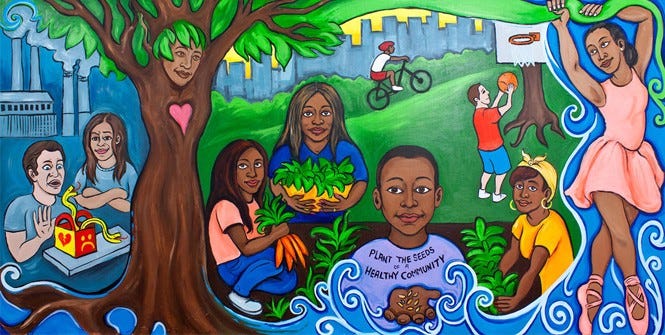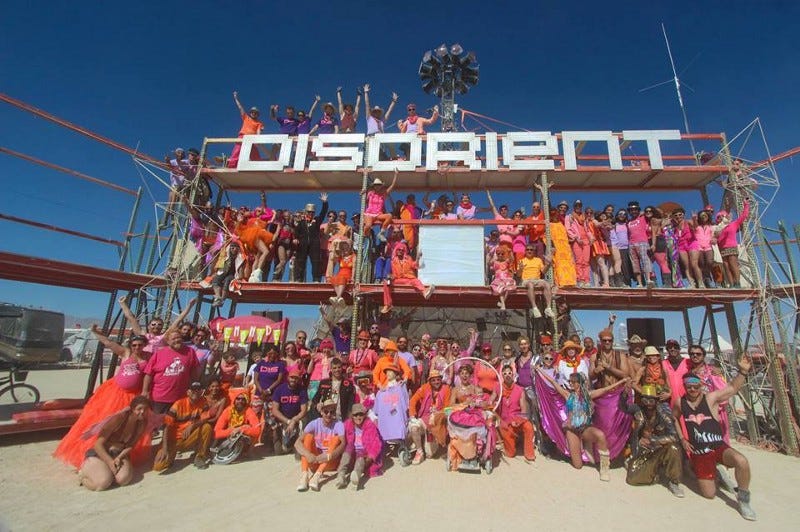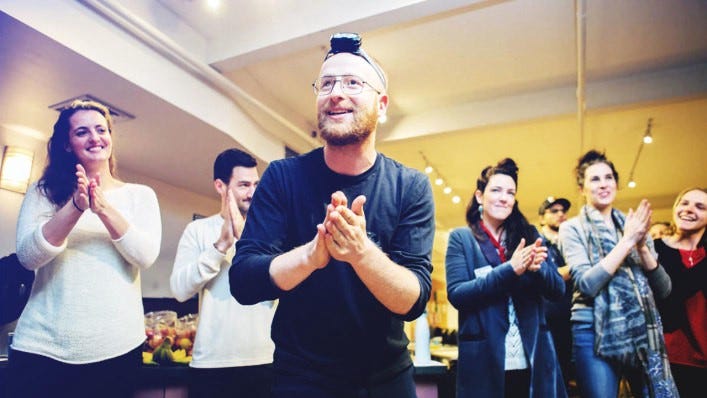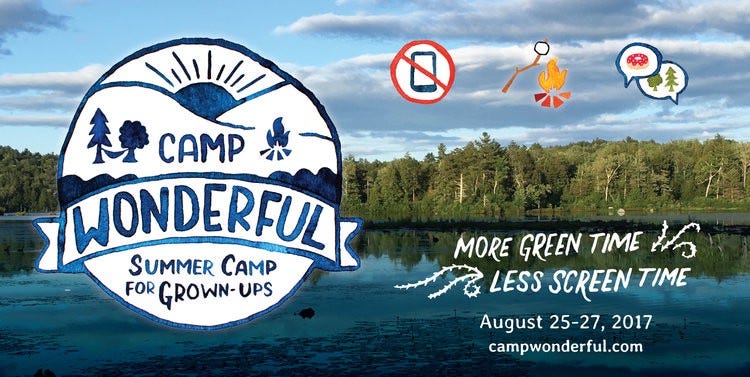Find Your Tribe: What I’ve Learned from Joining 8 New Communities
My mom put up a poster on the refrigerator: “How to Build Community.” I was eight years old, maybe nine. I didn’t get it.

My mom put up a poster on the refrigerator: “How to Build Community.” I was eight years old, maybe nine. I didn’t get it.
For my mom, community was everything. Her job as a New Haven city planner was all about organizing people in the community to create new schools, arts programs and local businesses.
As a kid, I took community for granted. I grew up in a single-parent household with my mom and sister. We shared a modest house on Hubinger Street with two other families. Neighbors took turns looking after us and getting the local kids together for kickball and soccer.
We knew the other families on our block. We went to each other’s birthday parties, knocked down piñatas, stayed up late watching scary movies. We walked outside and were surrounded by familiar faces.
Things are different as an adult. I’ve struggled to find community.
As I moved into bigger ponds — Harvard, Wall Street, New York City — I often felt a sense of isolation. I didn’t know many people. One of the cruel ironies of living in New York: You can be surrounded by millions of people, yet feel lonelier than you’ve ever been.
Community wasn’t something that fell into my lap. It was something I had to seek out proactively.
Kurt Vonnegut said:
“The best thing a young person can do is to create stable communities in which the terrible disease of loneliness can be cured.”
I started going to tech meetups and demo days. Met other startup founders. Collected business cards and 3D-printed toys.
I enrolled in a UCB improv class. Played Zip Zap Zop and Knife Thrower. Wrote an article on what I learned.
I went to Jewish community events at JICNY, MJE, Soho Synagogue and Meor. Volunteered helping elderly Jewish families. Got invited to Shabbat dinners, Torah classes and Purim parties. Watched people lose their shit when they heard I’d never been to Israel.
I joined Norwood and Soho House, private clubs for creative types. Went to art classes, panel discussions and concerts. Ate lots of avocado toast.

I got involved with Disorient, an arts and music collective that runs a camp at Burning Man. I volunteered at the group’s warehouse in Long Island City, building crates and hauling equipment. I was drawn to the community’s principles: gifting, radical inclusion, communal effort and participation.
What makes a good community?
David Spinks (founder of CMX) highlights 4 elements of building a community:
1. Identity: Bring together a group with a shared perspective on a subject or problem. Find a specific identity people share but are unable to express.
2. Trust: Make people feel confident if they participate in the community they’ll get value. It’ll be worth their investment of time.
3. Participation: Being part of a shared experience with others in the community should make you feel an immediate connection. There’s a common language and exchange that makes you feel connected, whether it’s a dinner, brunch, protest, or fundraiser.
4. Reward: People must get value from participation — either intrinsic value (i.e. good feelings) or extrinsic value (e.g. knowledge).
This year I’ve participated in new approaches to building community:
Touchpoint
I wasn’t sure what to expect when I got invited to Touchpoint, a “town hall” about sex and relationships. It’s an interactive storytelling experience where a group of 50–100 people discuss topics like: How do you balance personal privacy vs. openness and honesty in relationships? Is it OK to sleep with a co-worker?
The ground rules: What happens here stays here. Don’t interrupt. Keep it short. Keep an open mind.
It’s amazing to hear people talk candidly about issues related to monogamy vs. polyamory, sexual fantasies, and how to deal with jealousy in a relationship. The town hall promotes a type of openness that’s rare even among close friends.
Participants in Touchpoint are open-minded, raw and vulnerable. Their stories make you reflect on your own life and inspire better relationships. It’s one of the best new communities I’ve experienced this year.

Caveday
On a recent Sunday I walked into a Tribeca co-working space, checked my phone at the door and set out to work. Joining me were dozens of writers, artists and creative professionals. We worked for hour-long sprints with short breaks for stretching or creative exercises. Coaches were available for meditation and brainstorming help. At the end of the day, people had made amazing progress.
I heard about Caveday from Jeremy Redleaf. The guiding principles: Come with an intention — focus on one project. Don’t task switch. Finish the draft. Don’t worry about the first one being perfect.
It’s a simple but powerful twist on the traditional co-working arrangement — setting intentions upfront and knowing you’re sharing later makes a real impact. At each Caveday I met writers, filmmakers, entrepreneurs. We discussed productivity tips and creative tools.
I felt a real sense of community. It’s inspiring to be around other creative professionals with a shared sense of purpose.
Why do we need community?
It makes us happier and healthier. It could even save our life.
Loneliness has emerged as a major public health issue. Half of Americans are not engaged in communities. People who are socially isolated have a 3x higher mortality rate. Being lonely is as risky as smoking or obesity.
Research shows there are 4 pillars of a meaningful life:
· Sense of belonging: The feeling we get from relationships and community.
· Purpose: Having long-term goals in life that reflect our values and serve the greater good.
· Storytelling: How we weave our life experiences into a coherent narrative that defines our identity.
· Transcendence: Experiences that fill us with awe or wonder and diminish our sense of self-importance.
In his book Tribe, Sebastian Junger argues that veterans’ high rates of PTSD and suicide are directly related to the isolating effects of modern society. Living alone in a suburb or city isn’t natural for us. Humans evolved in close-knit tribes:
“We should recognize that by shrinking our network of strong social ties to our immediate families, we lose something important to our health and social identities, with the predictable result that we are ridden with anxiety and loneliness. We are meant to have tribes, to be among people who know us and care about us.”
This summer I’ll be trying a new experiment in community. I’m going to camp!

Camp Wonderful
Randy Kohn’s startup had been acquired. He was looking for what to do next. He missed the camaraderie of his old summer camp. He and his camp friends wondered: How can we help adults recreate our most cherished childhood experiences?
The result is Camp Wonderful, an adult summer camp running August 25–27 in the Berkshires. The camp’s guiding principles: Leave technology behind. Let go of time. Play, connect, reflect. Embrace new names. Be substance free. Be camp-years-old.
How do grown-ups go from being total strangers on the first day to becoming life-long camp friends? Simply: time spent together doing things you love. Swinging on a flying trapeze, canoeing to Blueberry Island to find the next treasure hunt clue, a hard-hitting game of volleyball, or a quiet reading spot in a hammock under a tree.
Every startup, every political movement begins like this. The oldest institutions around today — religions, cities, universities — they succeed by creating a strong, persistent sense of identity. They create emotional safety, a place you can be yourself.
What have you done to build community in your life?


